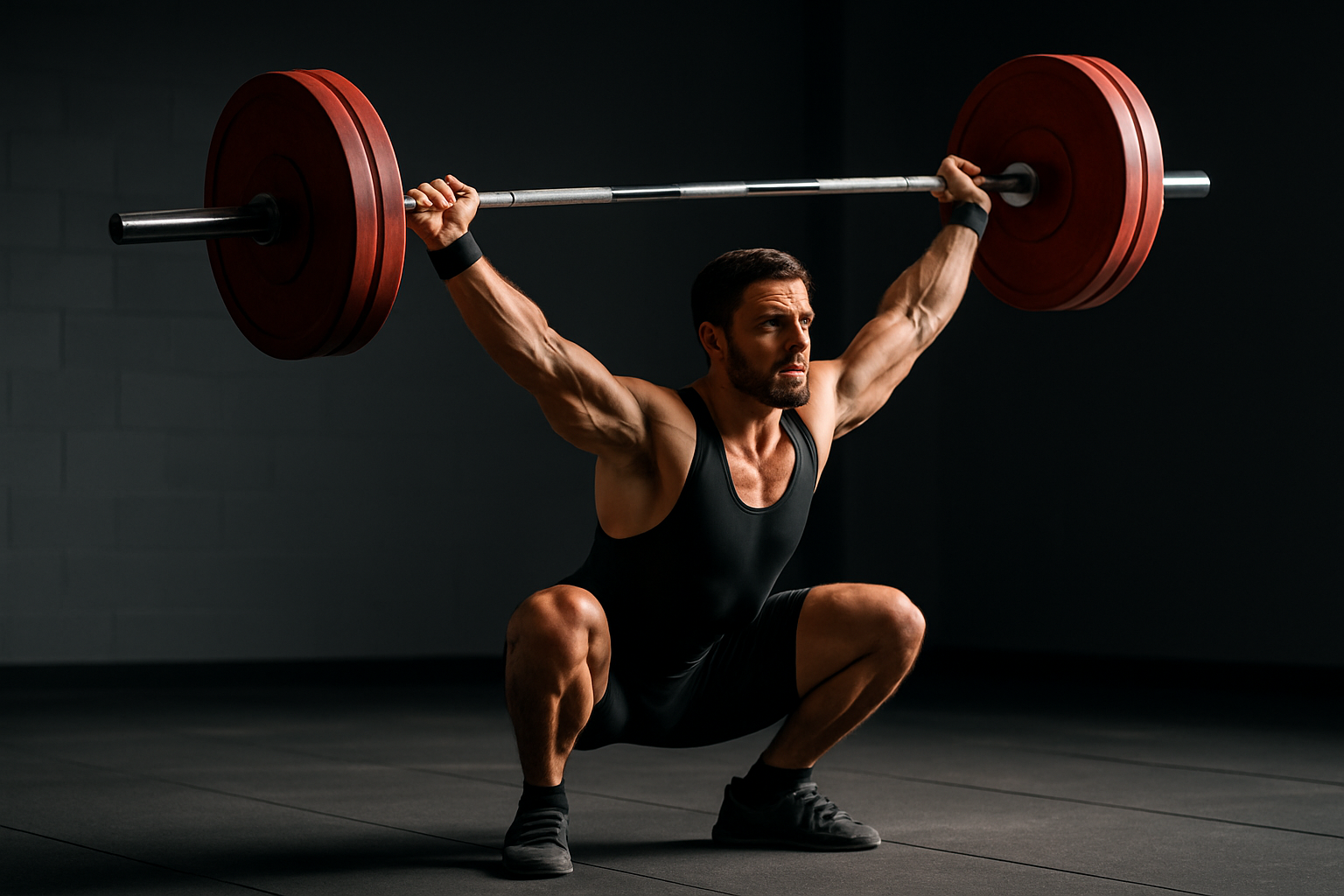Biomechanics of Olympic Weightlifting: Precision in Power
The thunderous clang of metal on metal echoes through the arena as a lifter hoists an impossibly heavy barbell overhead. Olympic weightlifting, a sport that combines raw strength with exquisite technique, captivates audiences worldwide. But beneath the surface of these awe-inspiring feats lies a complex interplay of physics, physiology, and biomechanics that pushes the human body to its limits.

Modern Olympic weightlifting emerged in the late 19th century, with the first Olympic competition held in 1896. Over the decades, the sport has evolved, with advancements in training methodologies, equipment design, and scientific understanding of human biomechanics contributing to ever-increasing world records.
The biomechanics of Olympic weightlifting is a fascinating field of study, combining principles from physics, anatomy, and kinesiology. Understanding these principles is crucial for athletes and coaches alike, as it allows for the optimization of technique, reduction of injury risk, and maximization of performance potential.
The Snatch: A Symphony of Speed and Precision
The snatch, often considered the more technically demanding of the two Olympic lifts, requires lifters to move a barbell from the ground to an overhead position in one continuous motion. This explosive movement can be broken down into several key phases, each with its own biomechanical considerations.
The initial pull phase begins as the lifter breaks the barbell from the ground. During this phase, the lifter must maintain a relatively constant back angle while extending the knees. This positioning allows for optimal force transfer from the legs to the barbell. Research has shown that successful lifters generate peak ground reaction forces of up to 2.5 times their body weight during this phase.
As the barbell passes the knees, the lifter enters the transition phase. Here, the hips begin to extend more rapidly, and the shoulders start to move backward relative to the bar. This repositioning is crucial for setting up the explosive second pull phase. Electromyographic studies have demonstrated high activation of the quadriceps, hamstrings, and gluteal muscles during this transition.
The second pull is where the magic happens. In a fraction of a second, the lifter fully extends the hips, knees, and ankles in a coordinated explosion of power. This triple extension generates vertical velocities of the barbell up to 3 meters per second. The rapid plantar flexion of the ankles, often referred to as the “jump,” creates a brief moment of weightlessness that allows the lifter to reposition under the bar.
The Clean and Jerk: A Two-Act Performance
The clean and jerk, while sharing some similarities with the snatch, presents its own unique biomechanical challenges. This lift is divided into two distinct parts: the clean, which brings the barbell from the ground to the shoulders, and the jerk, which propels it overhead.
The clean follows a similar pattern to the snatch in its initial phases. However, the receiving position differs significantly. Instead of catching the bar overhead, the lifter must rapidly drop under the bar and receive it on the shoulders in a front squat position. This requires exceptional flexibility in the wrists, elbows, and shoulders.
Biomechanical analysis has revealed that successful cleaners exhibit a characteristic “S” curve in the barbell’s trajectory. This slight backward movement of the bar during the second pull allows for a more advantageous receiving position. Interestingly, this curve is less pronounced in female lifters, likely due to differences in body proportions and strength ratios.
The jerk portion of the lift introduces new biomechanical considerations. The initial dip and drive phase requires precise timing and coordination. Studies have shown that elite lifters achieve peak bar velocities of up to 2 meters per second during the drive phase. The split jerk technique, favored by most competitive lifters, involves rapidly moving the feet into a split stance to lower the body under the bar.
Kinetic Chain and Force Production
Understanding the kinetic chain in Olympic weightlifting is crucial for optimizing performance. The sequential activation of muscle groups, starting from the legs and moving up through the trunk and arms, allows for the efficient transfer of force from the ground to the barbell.
Research using force plate technology has revealed that successful lifts are characterized by a rapid increase in ground reaction force during the second pull phase. This force can exceed 3,000 Newtons in elite male lifters. Interestingly, studies have shown that the rate of force development (RFD) is more critical than absolute strength in determining lifting success.
The role of the trunk muscles in maintaining stability and transferring force cannot be overstated. Electromyographic studies have demonstrated high activation of the erector spinae and abdominal muscles throughout the lifting movements. This core stability is essential for maintaining proper posture and preventing energy leaks in the kinetic chain.
Joint Angles and Leverages
The positioning of joints throughout the lifting movements plays a crucial role in maximizing mechanical advantage. At the start of both lifts, successful athletes typically exhibit knee angles between 135-145 degrees and hip angles between 55-65 degrees. These angles allow for optimal tension in the leg muscles and favorable moment arms for force production.
During the catch phase of the snatch, elite lifters achieve remarkably acute knee angles, often below 60 degrees. This deep squat position requires exceptional mobility and strength in the lower body. Similarly, in the receiving position of the clean, knee angles typically range from 60-90 degrees, depending on the lifter’s anthropometry and technique preferences.
The overhead position in both lifts demands significant shoulder mobility and stability. Biomechanical analysis has shown that successful lifters maintain the barbell within a narrow range directly above the base of support. Even small deviations from this optimal position can result in failed lifts or increased injury risk.
Anthropometry and Individual Variations
One of the fascinating aspects of Olympic weightlifting biomechanics is the influence of individual anthropometry on technique. Lifters with different limb lengths and body proportions must adapt their movements to optimize leverage and force production.
For example, lifters with longer legs relative to their torso may need to adopt a wider stance and more upright starting position to maintain balance and proper bar path. Conversely, those with shorter legs may benefit from a narrower stance and more forward-leaning torso angle.
These anthropometric differences also influence the choice between split and squat jerk techniques. Lifters with longer arms relative to their torso height may find the split jerk more advantageous, as it allows for a lower receiving position without compromising overhead stability.
Injury Prevention and Biomechanical Considerations
While Olympic weightlifting is generally considered a safe sport when performed with proper technique, the high forces involved do present some injury risks. Understanding the biomechanics of these lifts is crucial for developing effective injury prevention strategies.
The lower back is a common site of injury in weightlifters, particularly during the pull phases of both lifts. Maintaining a neutral spine position throughout the movement is essential for distributing forces evenly and minimizing shear stress on the intervertebral discs. Biomechanical models have shown that even small deviations from neutral spine alignment can significantly increase compressive and shear forces on the lumbar spine.
The shoulder complex is another area of concern, especially during the overhead portions of both lifts. Achieving and maintaining proper scapular positioning is crucial for optimal force transfer and injury prevention. Studies using 3D motion capture have revealed that successful lifters exhibit consistent patterns of scapular upward rotation and posterior tilt during the catch and recovery phases.
Wrist injuries are also common in Olympic weightlifting, particularly during the clean. The extreme wrist extension required to maintain the front rack position can place significant stress on the wrist joints and surrounding soft tissues. Biomechanical analysis has shown that wrist extension angles can exceed 100 degrees in some lifters, approaching the limits of normal range of motion.
Training Implications of Biomechanical Research
The insights gained from biomechanical research have significant implications for training methodology in Olympic weightlifting. Coaches and athletes can use this knowledge to develop more effective and targeted training programs.
One area of focus is the development of explosive strength, particularly in the hip and knee extensors. Plyometric exercises, such as depth jumps and box jumps, have been shown to improve rate of force development and vertical jump performance, both of which correlate strongly with weightlifting success.
Technique drills that emphasize proper positioning and timing of movements are also crucial. For example, hang snatch and clean variations allow athletes to focus on the critical second pull phase without the complexity of the full lift. These drills can be performed with lighter loads and higher repetitions to reinforce optimal motor patterns.
Flexibility and mobility work, particularly for the ankles, hips, and shoulders, is essential for achieving the positions required for efficient lifting. Dynamic stretching routines and mobility exercises should be incorporated into warm-up protocols and standalone sessions to improve range of motion and reduce injury risk.
Technology in Biomechanical Analysis
Advancements in technology have revolutionized the field of weightlifting biomechanics. High-speed video analysis, once limited to laboratory settings, is now accessible to coaches and athletes through smartphone applications. These tools allow for frame-by-frame analysis of lifting technique, providing immediate feedback on bar path, joint angles, and timing of movements.
Force plate technology, which measures ground reaction forces during lifts, has become more affordable and portable. This allows for precise quantification of force production and asymmetries, helping athletes and coaches identify areas for improvement and track progress over time.
Wearable sensors, such as inertial measurement units (IMUs), are emerging as valuable tools for biomechanical analysis in weightlifting. These devices can provide real-time data on barbell velocity, acceleration, and trajectory, offering insights into lift efficiency and consistency.
Three-dimensional motion capture systems, while still primarily used in research settings, are becoming more accessible for elite training facilities. These systems provide detailed information on joint kinematics and kinetics, allowing for comprehensive analysis of lifting technique and identification of potential injury risk factors.
The Role of Fatigue in Weightlifting Biomechanics
Fatigue is an inevitable aspect of weightlifting training and competition, and its effects on biomechanics are significant. Understanding how fatigue alters movement patterns and force production is crucial for developing effective training programs and competition strategies.
Research has shown that as fatigue sets in, lifters tend to exhibit decreased vertical displacement of the barbell, reduced peak velocity, and altered joint kinematics. These changes can lead to less efficient lifts and increased risk of technical breakdown.
Interestingly, studies have found that experienced lifters are better able to maintain proper technique under fatigue compared to novices. This suggests that developing a robust motor pattern through consistent practice is crucial for performance consistency, especially in competitive settings where multiple attempts are required.
Coaches and athletes must carefully consider the balance between training volume, intensity, and recovery to optimize performance while minimizing the negative effects of fatigue on lifting biomechanics.
Gender Differences in Weightlifting Biomechanics
While the fundamental principles of weightlifting biomechanics apply to both male and female athletes, research has revealed some interesting gender-specific differences. Understanding these differences is important for tailoring training programs and technical instruction to individual athletes.
One notable difference is in the relative contribution of different muscle groups during lifting. Studies have shown that female lifters tend to rely more heavily on their quadriceps muscles during the pull phases, while male lifters show greater activation of the hamstrings and gluteal muscles. This may be due to differences in muscle fiber composition and strength ratios between genders.
Bar path analysis has also revealed some gender-specific patterns. Female lifters often exhibit a more vertical bar path during the snatch and clean, with less horizontal displacement during the second pull phase compared to male lifters. This may be related to differences in upper body strength and the need to minimize the distance the bar must travel.
In the jerk portion of the clean and jerk, female lifters typically show a greater reliance on the split technique, while male lifters more commonly employ the power jerk or squat jerk variations. This preference may be influenced by differences in lower body strength and stability.
These gender-specific biomechanical patterns highlight the importance of individualized coaching and technique development, rather than a one-size-fits-all approach.
The Future of Weightlifting Biomechanics
As technology continues to advance and our understanding of human physiology deepens, the field of weightlifting biomechanics is poised for exciting developments. Several areas of research show particular promise for enhancing performance and reducing injury risk.
Artificial intelligence and machine learning algorithms are being developed to analyze lifting technique in real-time, providing instant feedback to athletes and coaches. These systems could potentially identify subtle technique flaws or asymmetries that might be missed by the human eye, allowing for more targeted training interventions.
Virtual and augmented reality technologies offer new possibilities for technique training and visualization. Athletes could practice lifts in virtual environments, receiving immediate feedback on their form and bar path. This technology could be especially valuable for mental rehearsal and preparation for competition settings.
Advancements in tissue engineering and regenerative medicine may lead to new strategies for injury prevention and recovery. Understanding the biomechanical stresses placed on specific tissues during weightlifting could inform the development of targeted strengthening protocols or even personalized tissue grafts for injury repair.
Genetic research is shedding light on individual variations in muscle fiber composition, tendon elasticity, and other factors that influence weightlifting performance. In the future, biomechanical analysis may be combined with genetic profiling to create highly individualized training programs that maximize each athlete’s unique physiological strengths.
The Art and Science of Olympic Weightlifting
Olympic weightlifting represents a unique blend of raw power, refined technique, and split-second timing. The biomechanics underlying these impressive feats of strength offer a fascinating window into the capabilities of the human body.
From the explosive triple extension of the snatch to the precise timing of the jerk, every aspect of weightlifting technique is grounded in biomechanical principles. Understanding these principles allows athletes and coaches to optimize performance, minimize injury risk, and push the boundaries of human potential.
As research in this field continues to evolve, we can expect to see further refinements in training methodologies, technique analysis, and performance optimization. The marriage of cutting-edge technology with time-tested principles of strength and power development promises to keep Olympic weightlifting at the forefront of human athletic achievement.
Whether you’re a competitive weightlifter, a strength coach, or simply an admirer of human physical prowess, the biomechanics of Olympic weightlifting offer endless fascination and inspiration. As we continue to unravel the complexities of these movements, we gain not only a deeper appreciation for the sport but also valuable insights into the remarkable capabilities of the human body.





